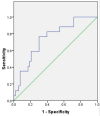Neutrophil-to-Lymphocyte Ratio Is Associated With Circumferential Wall Enhancement of Unruptured Intracranial Aneurysm
- PMID: 35669880
- PMCID: PMC9163366
- DOI: 10.3389/fneur.2022.879882
Neutrophil-to-Lymphocyte Ratio Is Associated With Circumferential Wall Enhancement of Unruptured Intracranial Aneurysm
Abstract
Background and purpose: Neutrophil-lymphocyte ratio (NLR) predicts clinical outcomes in patients with stroke. Aneurysm wall enhancement (AWE) on high-resolution vessel wall magnetic resonance imaging (HR-VWI) is an inflammation marker for intracranial aneurysm (IA). This study aims to evaluate the association of NLR as a peripheral blood inflammatory marker with circumferential AWE in patients with IA.
Methods: We analyzed data of consecutive patients harboring IAs between September 2017 and December 2021 at our institution. The peripheral blood inflammatory indicators were compared between patients with ruptured and unruptured IAs. The presence of circumferential AWE in unruptured IA was identified and quantitatively measured using the aneurysm-to-pituitary stalk contrast ratio (CRstalk) on HR-VWI. We used the optimal cutoff value of 0.5 for CRstalk to differentiate circumferential AWE in unruptured IAs. We assessed the relationship of clinical, laboratory, and radiological characteristics with circumferential AWE and CRstalk ≥0.5 in unruptured IAs.
Results: The study group was composed of one hundred and twenty-five patients with 142 IAs. NLR level at admission was significantly higher in patients with ruptured IAs than those with unruptured IAs (7.55 vs. 1.81; P < 0.001). AWE on HR-VWI was present in 30 patients with unruptured IAs (38.5%), including 12 with focal AWE and 18 with circumferential AWE. NLR (odds ratio (OR), 2.168; 95% CI, 1.149-4.088) and size (odds ratio, 1.370; 95% CI, 1.126-1.667) were independently associated with circumferential AWE in unruptured IA. NLR was also independently associated with circumferential AWE in small unruptured IA (<7 mm). Furthermore, NLR level at admission was associated with CRstalk ≥.5 in patients with unruptured IA. The optimal cutoff value of NLR for circumferential AWE was 1.86.
Conclusion: NLR is a valuable peripheral blood inflammatory marker is more often in the rupture status of IA and was associated with circumferential AWE on HR-VWI in unruptured IA.
Keywords: aneurysm wall enhancement; blood marker; intracranial aneurysm; neutrophil-lymphocyte ratio; vessel wall imaging.
Copyright © 2022 Wu, Zhong, Wang, Su, Chen, Li, Xiang, Cai and Shi.
Conflict of interest statement
The authors declare that the research was conducted in the absence of any commercial or financial relationships that could be construed as a potential conflict of interest.
Figures


References
LinkOut - more resources
Full Text Sources

